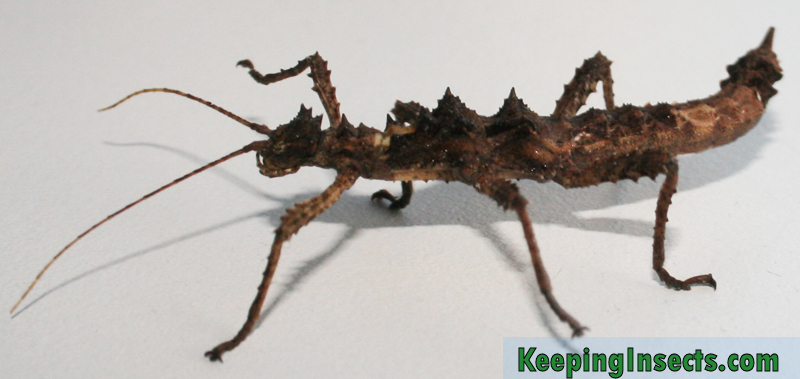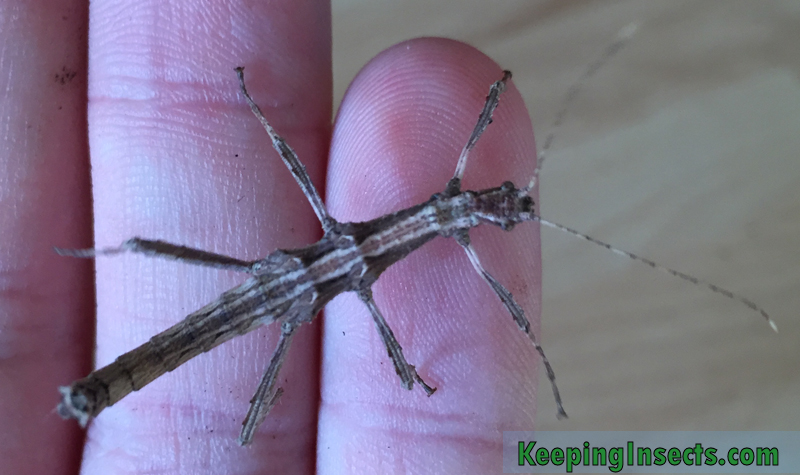The Thorny Stick Insect is a medium size stick insect with the Latin name Aretaon asperrimus. It’s PSG number is PSG 118. Originally it can be found on Saba, in Borneo, but nowadays it can be found in houses as an insect pet. It is easy to keep and has an interesting look, making it a fun stick insect species to keep.
Appearance of Aretaon asperrimus
The Thorny Stick Insect Aretaon asperrimus has a very spikey look when adult. Especially the males are adorned with huge spikes. The young stick insects are much more smooth and have shorter spikes. The spikes are not used to fight or sting, but in nature they do serve to make it harder to eat the stick insect.
The colors of the Thorny Stick Insect can differ from dark brown, to light brown to a bit greenish. The colors are dependend on the environment in which the stick insect lives. More moist environments then to produce darker stick insects, but is not entirely sure which conditions you need to provide to get a certain color.
Aretaon asperrimus stick insects will reach a body length of 5 cm (2 inch) for the males and 8 cm (3 to 3,5 inch) for the females. The females are much more larger and bulky when adult compared to the adult males. The males are more slender and have much larger spikes on their body. The young ones start out looking very similar, but as they get older you will see that they begin to show more and more of the features of their sex.
Behavior of the Thorny Stick Insect
Thorny Stick Insects are very quiet and docile animals. They are mostly active at night. They do not sting, bite or try to attack you. The mean looking spikes are not used in self defence. They can be handled easily and generally walk at slow pace.
Food for a Thorny Stick Insect
An Aretaon asperrimus will eat fresh leaves of bramble / blackberry, rose, oak, raspberry and even ivy. Don’t feed it exclusively on ivy. You can provide their food in a vase or cup of water to keep it fresh for a couple of days.
Housing, temperature and moisture for Aretaon asperrimus
Aretaon asperrimus can be housed in any terrarium or enclosure that is big enough. It should have some ventilation but not a lot, because you do want to keep the inside of the terrarium a bit more moist than normal room moisture. You can house multible stick insects of the same species together. The size of a terrarium for Aretaon asperrimus has to be at least 10 inches high (25 cm) and 7 inches wide (16 cm) but bigger is always much better. You could keep 5 adult stick insects of this species in a glass terrarium of 30 cm x 30 cm x 40 cm for example.
Aretaon asperrimus likes to live in a moist environment. Keep the terrarium moist by misting it with water and covering the floor with bedding that will absorb moisture. For example peat, moss or potting soil. More about keeping the humidity high can be found on our page Humidity and Drinking Water.
This species does not care about the temparature so much. You can keep the terrarium at room temperature, around 20 degrees Celsius (68 degrees Fahrenheit). Warmer is better because the insects will grow faster and be more active. Don’t go further up than 35 degrees Celsius (95 degrees Fahrenheit). At night you can allow the temperatures to drop a bit. If you want to read more about heating the terrarium, read our page Temperature.
Breeding and egg care
It’s easy to breed Aretaon asperrimus stick insects. When you have an adult male and an adult female they will breed by themselves and produce eggs. You can recognize the adult females because they have a long ovipositor at the end of their bodies. They use this to dig a hole in the ground and deposit their egg. Adult females will start to produce eggs around 2 to 3 weeks after they have become adults. You can collect the eggs and keep them in moist soil for 3 to 4 months. Keep them at a light place but make sure they stay moist. Keep the temperature around 20 degrees Celsius (68 degrees Fahrenheit).
The nymphs that are born out of the eggs will have the same needs as the adults. Make sure to provide them with humidity, fresh food and a nice terrarium to live in. After around 4 to 5 months they will be adult and the cycle can start again.








